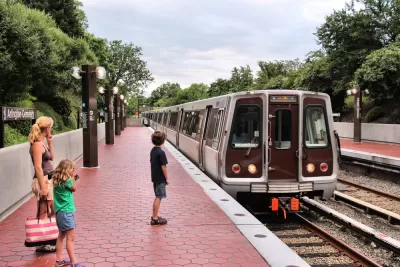The historically car-dependent county is hoping the planned revitalization of the Blue Line Corridor will boost the local economy and help maintain affordable housing.

In what Ethan Goffman calls "a radical break for a county with a history of developing in 'a spread out and automobile dependent' fashion," Maryland's Prince George’s County "has signed on to the transit-oriented development (TOD) revolution to boost its economy while helping the environment." According to the plan, "The Blue Line Corridor will become a major economic engine for the County by catalyzing development, creating jobs, and incentivizing the development of a sports and entertainment-branded corridor."
"The Blue Line would be the template for a much-needed economic boost for Prince George’s County that simultaneously helps the environment and maintains affordable housing." The plan "emphasizes business and economic development, crucial in a county with plenty of housing but relatively few jobs." Its authors hope it will attract large, institutional employers and raise the average annual salary in the area to a level closer to the rest of the D.C. region. "The plan’s second broad goal is to increase commercial tax collection by $100 million annually, enhancing much-needed local services. Third is increasing the population by 50,000 in areas near transit, including a mix of incomes and housing types."
"The plan’s fourth goal is preserving affordable housing and a diverse housing stock even in the midst of growth." The county also hopes to "increase food retail options in low-income areas to make fresh, healthy food widely accessible" and enhance "identifiable character" through public features and amenities.
"The plan is proactive on [the issue of displacement], calling for building 26,000 new residential units, 75% of which would be dedicated as affordable to households making less than 120% of the area median income," which could help fill the need for so-called 'missing middle' housing.
FULL STORY: Prince George’s County outlines plans for ambitious transit-oriented development along the Blue Line

Trump Administration Could Effectively End Housing Voucher Program
Federal officials are eyeing major cuts to the Section 8 program that helps millions of low-income households pay rent.

Planetizen Federal Action Tracker
A weekly monitor of how Trump’s orders and actions are impacting planners and planning in America.

Ken Jennings Launches Transit Web Series
The Jeopardy champ wants you to ride public transit.

Washington Legislature Passes Rent Increase Cap
A bill that caps rent increases at 7 percent plus inflation is headed to the governor’s desk.

From Planning to Action: How LA County Is Rethinking Climate Resilience
Chief Sustainability Officer Rita Kampalath outlines the County’s shift from planning to implementation in its climate resilience efforts, emphasizing cross-departmental coordination, updated recovery strategies, and the need for flexible funding.

New Mexico Aging Department Commits to Helping Seniors Age ‘In Place’ and ‘Autonomously’ in New Draft Plan
As New Mexico’s population of seniors continues to grow, the state’s aging department is proposing expanded initiatives to help seniors maintain their autonomy while also supporting family caregivers.
Urban Design for Planners 1: Software Tools
This six-course series explores essential urban design concepts using open source software and equips planners with the tools they need to participate fully in the urban design process.
Planning for Universal Design
Learn the tools for implementing Universal Design in planning regulations.
Heyer Gruel & Associates PA
Ada County Highway District
Institute for Housing and Urban Development Studies (IHS)
City of Grandview
Harvard GSD Executive Education
Toledo-Lucas County Plan Commissions
Salt Lake City
NYU Wagner Graduate School of Public Service


























